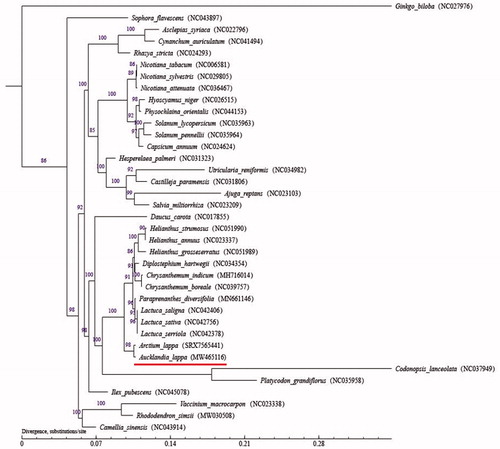Abstract
The complete mitochondrial genome of Aucklandia lappa was sequenced for the first time. The mitochondrial genome length was 320,439 bp, with 45.05% GC contents. There were 67 genes annotated, including 31 known protein-coding genes, 25 tRNAs, and six rRNAs. The maximum likelihood method was used to establish the phylogenetic tree of 37 species. Results have shown that A. lappa and Arctium lappa were sister groups. It reveals the genetic relationship between different species and provides a theoretical basis for the establishment of a classification system.
Aucklandia lappa Decne. is a perennial herb belonging to Aucklandia Falc., synonymous with Saussurea costus, Saussurea lappa, and Aucklandia costus (Rohit et al. Citation2020). Native to Yunnan Province in China, A. lappa, also known as ‘Guangmuxiang,’ later is mainly imported from places like Egypt, India and Nepal. In 1935, the herb was first introduced from India and successfully grown in Yunnan. Widely acclaimed for its superior quality, the species was given a new name ‘Yunmuxiang.’ The plant is widely cultivated in Sichuan (Mount Emei), Yunnan (Weixi, Kunming), Guangxi and Guizhou (Guiyang, Dushan). The root of A. lappa has medicinal value, mainly used to treat stomach diseases. The paste is applied to the inflamed area to relieve pain. The chemical constituents are terpenoids, steroids, phenylpropanoids, lignans, flavonoids and so on (Benedetto et al. Citation2019; Rohit et al. Citation2020). According to the Chinese pharmacopeia (National Pharmacopeia Commission Citation2020), Radix Aucklandiae for medicinal use should contain at least 15% total costunolide (C15H20O2) and dehydrocostus lactone (C5H18O2). Studies have shown that costunolide and dehydrocostus lactone are potential anticancer drugs (Chen et al. Citation1995; Jeong et al. Citation2002; Cho et al. Citation2004). So far, the whole chloroplast genome of A. lappa has been sequenced (Xu et al. Citation2019).
Fresh leaves of A. lappa were collected from Weining County, Guizhou Province, China (E 104°32′46″, N 26°47′15″). The voucher specimen was identified by Professor Tingguo Kang (Liaoning University of Chinese Medicine, Dalian, China). The voucher specimen and genomic DNA were deposited at the herbarium of Liaoning University of Chinese Medicine (Liang Xu [email protected], A. lappa number: 10162201125069LY). Total mitochondrial genomic DNA was extracted from fresh leaves and sequenced by Illumina NovaSeq 6000 and PacBio Sequel II platform. Assemble the sequencing data with GetOrganelle v1.6.4 (Jin et al. Citation2020) and correct the bases with Pilon v1.22 to get the final genome sequence of mitochondria. The protein coding sequences of mitochondria were compared with known protein databases (NR, Swiss-Prot, eggNOG, KEGG, GO) to predict protein-coding genes.
The mitochondrial genome of A. lappa was 320,439 bp in length with the typical circular structure, and GC content was 45.05%. There were 67 genes annotated, including 31 known protein-coding genes, 25 tRNAs, and six rRNAs. The accumulated length of the coding gene was 29,127 bp, and the length of the coding region accounted for 9.09% of the genome. In addition, we found that eight genes (nad5, nad2, ccmFc, cox2, nad1, nad4, nad7, rps3) contained 20 introns.
As we all know, phylogenetic tree is used to describe the evolutionary relationship between species. We selected the complete mitochondrial genome of 37 species (including A. lappa) to construct the phylogenetic tree, using the maximum-likelihood method with the model GTR + I + G (). Among them, Ginkgo biloba as the outgroup. The phylogenetic tree showed that A. lappa and Arctium lappa were sister groups and Ginkgo biloba was far from the other species. The whole mitochondrial genome sequencing of A. lappa provides the conditions and theoretical basis for its application in plant phylogeny. At present, there are few mitochondrial genomes available in Asteraceae. These data will provide a basis to analyze the phylogenetic position of A. lappa.
Disclosure statement
No potential conflict of interest was reported by the author(s).
Data availability statement
The genome sequence data that support the findings of this study are openly available in GenBank of NCBI at (https://www.ncbi.nlm.nih.gov/) under the accession NO. MW465116. The associated BioProject, SRA, and Bio-Sample numbers are PRJNA690192, SRX9818099 (PACBIO_SMRT), SRX9818098 (ILLUMINA) and SAMN17245959, respectively.
Additional information
Funding
References
- Benedetto C, Maurizio DA, Marisabel M, Pratti P, Pramod S, Sandeep S, Chiara S, Luigi M. 2019. Chemical and biological evaluation of essential oil from Saussurea costus (Falc.) Lipsch. from Garhwal Himalaya collected at different harvesting periods. Nat Prod Res. 33(16):2355–2358.
- Chen HC, Chou CK, Lee SD, Wang JC, Yeh SF. 1995. Active compounds from Saussurea lappa Clarke that suppress hepatitis B virus surface antigen gene expression in human hepatoma cells. Antiviral Research. 27(1–2):99–109.
- Cho JY, Kim AR, Jung JH, Chun T, Rhee MH, Yoo ES. 2004. Cytotoxic and proapoptotic activities of cynaropicrin, a sesquiterpene lactone, on the viability of leukocyte cancer cell lines. Eur J Pharmacol. 492(2–3):85–94.
- Jeong SJ, Itokawa T, Shibuya M, Kuwano M, Ono M, Higuchi R, Miyamoto T. 2002. Costunolide, a sesquiterpene lactone from Saussurea lappa inhibits the VEGER KDR/FLK-1 signaling pathway. Cancer Letters. 187(1–2):129–133.
- Jin JJ, Yu WB, Yang JB, Song Y, dePamphilis CW, Yi TS, Li DZ. 2020. GetOrganelle: a fast and versatile toolkit for accurate de novo assembly of organelle genomes. Genome Biol. 21(1):241.
- National Pharmacopoeia Commission. 2020. People's Republic of China pharmacopoeia A. Beijing: China Medical Science and Technology Press.
- Rohit KN, Aaliya A, Renu CG, Prem KK, Rohit G. 2020. Aucklandia costus (syn. Saussurea costus): ethnopharmacology of an endangered medicinal plant of the Himalayan region. J Ethnopharmacol. 263:113199–113199.
- Xu LS, Sonia HM, Alfonso S, Mercè GC, Chen YS. 2019. Phylogeny, origin and dispersal of Saussurea (Asteraceae) based on chloroplast genome data. Mol Phylogenet E. 141:106–613.

